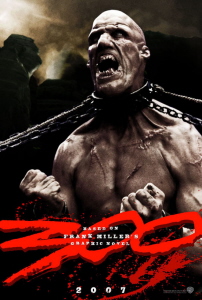 Frank Miller doesn’t look that well. He’s sort of blotchy, and his voice is raspy. He’s sucking on a lozenge, and I can’t tell if he had a long night or is just coming down with something. Happily, Miller slowly seems to come into his own, and by the evening, when he joins us for dinner, he seems pretty OK. Maybe it’s the Montreal cold getting to him – my very capillaries feel sluggish.
Frank Miller doesn’t look that well. He’s sort of blotchy, and his voice is raspy. He’s sucking on a lozenge, and I can’t tell if he had a long night or is just coming down with something. Happily, Miller slowly seems to come into his own, and by the evening, when he joins us for dinner, he seems pretty OK. Maybe it’s the Montreal cold getting to him – my very capillaries feel sluggish.
Miller is visiting the set of 300, the movie adaptation of his famed graphic novel about 300 Spartan warriors who held off a horde of Persians in a suicide bid that probably changed the very course of civilization. I’m also visiting the set of 300, along with a number of other journalists – Miller is going to be around for a couple more days, but we’re here for just the one. In the middle of the day, sometime after lunch, Miller joins us in a conference room above the stages for a roundtable interview session.
This interview was conducted in December of 2005, and you would think that in the 13 or 14 months since, some of the questions would have become outdated. After all, Miller is a comic book guy, and comics come out every month, right? He’s writing All-Star Batman & Robin for DC Comics, a sort of free-for-all Batman title unhindered by previous continuity, and the legendary Jim Lee is doing the art. But it isn’t like a slew of All-Star issues have come out since we talked here – in fact, I do believe just one has hit the stands betweem 2005 and the opening month of 2007 (in fairness, there may have been two, I’m not fully certain).
In case you’re not a comic book person, there’s no way to overplay Frank Miller’s importance in the last couple of decades. He did what is considered THE defining run on Daredevil, bringing ninjas into the comics mainstream and creating Elektra, one of the most popular female characters in all comics. His Batman: Year One rewrote the book on who the Batman is; his Batman: The Dark Knight Returns, along with Alan Moore’s Watchmen, deconstructed the very concepts of superheroes and established them as playthings for adults. Batman Begins exists only because of Frank Miller. His Sin City, besides being adapted into a hit film that pushed the edges of modern filmmaking, helped usher in a new world of publishing, bringing indie and non-superhero books into the comic mainstream.
We heard this is your first day on set? What do you think?
I’m in love. It’s so much fun. The cast and crew are obviously having a ball. And it’s as stylized as I prayed it would be. This is not a realistic story, as much as it’s based on reality. It’s a very stylized version.
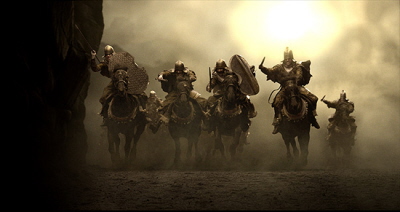
Why was this story one that interested you?
I always loved this story. It’s the best story I ever got my hands on. I was a little boy, seven years old, and I saw this clunky old movie from 20th Century Fox called The 300 Spartans. I was sitting next to my brother Steve, who was two years older than I was, so we were seven and nine and too cool to sit with our parents, so our parents were in the row behind us. Towards the end of this thing, I went, ‘Steve, are the good guys gonna lose?’ He said, ‘I don’t know, ask Dad!’ So I leaned back and said, ‘Dad, are the good guys gonna die?’ ‘I’m afraid so, son.’ I went and sat down and watched the end of the movie and the course of my creative life changed, because all of a sudden heroes weren’t guys getting medals at the end of Star Wars. They weren’t Harry Potter getting cheered by his goddamned classmates. They were people who did the right thing, and damn the consequences. Ever since then, heroic sacrifice has been a theme of my work.
So I focused on the story, I studied it, and then I realized I thought I had the skills to pull it off finally. Also, I didn’t want to be one of those losers who sits and talks about a story he wants to do for the rest of his life. I read up more about it and then I went to Greece and spent three weeks on the Aegean, studying Greek terrain and old Greek battles. I went to the Hot Gates and absorbed it all. I learned that researching history starts out like a chore but quickly turns into a treasure trove. The story got better the more I researched it. It’s an amazing story.
The art is so stylized, and the color palette Lynn Varley used was so specific. Were you skeptical that anyone could pull that off?
I’m thrilled with what I’ve seen so far. When I licensed the book I wasn’t yet a director. Now I can only envy Zach Snyder for being the director of this. But it’s in good hands.
I was mainly skeptical about the courage they would have, but the producers and Zach approached this with utter determination to do it right. They are keeping very close to the book but adding their own dimension to it.
Back when they were negotiating with you, after you had some bad experiences with Hollywood, were you worried?
I approached it with a lot of concern. Same thing with Sin City, because I thought are they really going to have the balls to do it right? Will the Spartans end up alive at the end? It was mainly [producer] Gianni [Nunnari]’s determination to tell this whole story as is that convinced me.
Had anyone else approached you?
If you do a comic book, you get an option deal. It’s almost automatically in the mail. But I always turn them down. I was just convinced by Gianni’s determination.
There’s a scene in The Big Fat Kill that was obviously a version of the Hot Gates. Why didn’t you do that for Sin City, and did it help make you want to do 300?
When I did that one shot in Sin City that you’re referring to, in referencing the Hot Gates, I threw that in almost like a dog marking his territory – nobody touch this story, it’s mine! I knew it would be my next book. I was just beginning research.
Did you and Robert Rodriguez ever consider using that in the Sin City movie?
No, not really. It would have been very disconcerting and weird in an already pretty strange movie.
This is obviously different from some of the other sword and sandal movies lately like Troy and Alexander –
[laughs] I would hope so!
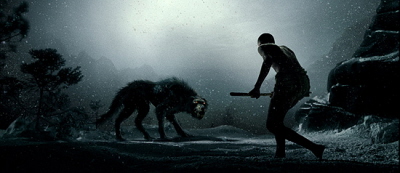
How do you feel that you wrote this long before those movies, but now this film will be compared to them?
Well, now we can finally have a good one.
When this movie started up there were a couple of other possible Spartan movies in development. What edge did this movie have?
I think the artwork helps a lot. When we were shooting Sin City having the artwork there was a real godsend for the cast and crew, because it answered tons of questions. Also, this is a very streamlined version of the story; the other versions were much more elaborate, straining to be an epic, rather than the sudden, scary story 300 deserves to be. It’s a three day battle – you don’t want to dwell.
You co-directed Sin City. Is there a frustration in not co-directing this? Is it hard to relinquish control?
It’s not hard. It’s agonizing. Damn Zach Snyder! But no, it’s in good hands.
Did you enjoy co-directing?
Try and stop me. I’m finishing the script for Sin City 2 and another film as well and I can’t wait to get behind the camera again.
So is this going to be the last Frank Miller adaptation that is not directed by Frank Miller?
Yeah.
So if Martha Washington ever makes it to the screen, it’ll be with you behind the camera?
That’s right.
David Cronenberg said that he doesn’t use storyboards, and he actually brought up Sin City as an example of artists not understanding lenses and cinematography. What’s your response to that?
I’ve got nothing but respect for David Cronenberg. The way Sin City was shot, much as this is – he’s using blue screen, we used green screen – turns it into something much closer to what I saw on my drawing board. I found it wonderful that way, and I found the relationship between drawing and filming with CGI to be so close as to be ridiculous. And that’s what Robert Rodriguez had predicted to me, and I didn’t trust him until I was there and had seen the footage. The two forms, the two media, are deeply related and a lot of what works in one works in the other.
Irony is definitely in the air when a Frank Miller independent comic is being produced by Warner Bros. Have you been talking with them, or is all of that mostly through the producers?
Mostly through the producers, but I have an excellent relationship with Warner Bros. I worked on the last Batman movie for a while, and they publish my Batman comics. Generally you do need a Gianni out there and a Zach to muscle it through.
There are some new characters introduced in this. How do you feel about that?
I’ve been around the block. I know what happens when you make a movie – sometimes you collapse characters into each, sometimes you create new ones. You make adjustments. I’m sitting back and taking a ride right now. My advice is available anytime they want it.
Did they come to you to talk about it?
Sure, we talked it over. But it’s Zach’s movie, and I know what it’s like to direct, and the last thing you need is some producer hopping all over you like a grasshopper. I give him a lot of latitude. I don’t want to interfere with his process.
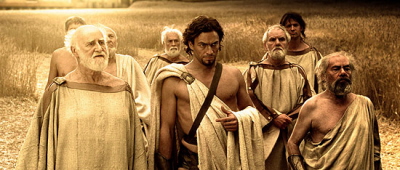
What’s your process? How long does it take you to do a graphic novel?
It’s usually about a year and half that it takes me to do a Sin City or a 300. 300 really caught fire and I was turning it out rapidly towards the end, because I couldn’t think about anything else. In my morning shower I would be composing words and pictures in my head.
The internet allows fans to put their reactions out there so much more than ever before. Recently I was looking at the fan reactions to All-Star Batman & Robin, and I was wondering what it would have been like if the internet had been there for The Dark Knight. Do you read that stuff, do you pay attention?
I can’t. I really can’t. If the internet had been around for The Dark Knight, they would have been complaining as much as they’re complaining now because the internet is there for people to complain. If Batman says ‘Goddamn,’ they get the vapors. It’s true.
With Martha Washington – is that something that you think the time may be ripe for?
I hope to. I just have so many ideas and so many stories I’m working on that it’s kind of hard to put first. But I have to do Sin City while I can, so that’s first.
We’ve heard there’s going to be a Sin City trilogy. True?
If I have my way there’s going to be five. But that’s if I had my way. Five would take care of all the graphic novels, but there’s new material I’m writing for the second movie, and that would be a new graphic novel too. It’s a Nancy Callahan story I’ve been wanting to do.
When did you know you could draw?
I’m still working on it! My mother tells me that I came into kitchen when I was six years old with some pieces of typing paper folded over and stapled and with childish scrawls on them and I said, ‘I’m doing this for the rest of my life.’ I’ve been drawing ever since I could remember, but it’s just that when I was about 19 I got good enough that I could get published.
How did your style evolve to where it is in 300?
I’m a cartoonist more than an illustrator, and much of comic book art in America has been based on illustration. I like to stylize like crazy, and I believe that comics should be about expression and evocation rather than photography.
And should they be about politics?
I think it’s an easy fit for political satire. Especially superheroes, because they’re so cartoony and so outrageous that you drop them into a world that includes real life people – you drop The Flash into a world that has Donald Rumsfeld into it, you end up with something insanely funny.
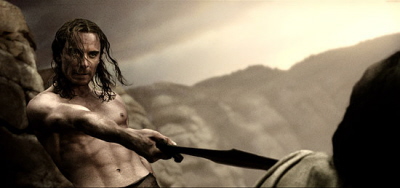
With this are you trying to comment on the excesses of war? With scenes like guys up on spikes?
No. It’s just a sign of the Spartans’ barbarity. They’re the oldest society, and they were quite brutal. The most offensive thing they ever did was tossing all those messengers into the well because you never kill the messenger; it’s considered blasphemy. But the Spartans didn’t give a damn, they’d commit blasphemy.
You have to understand, these people were all slaveholders. They were trained soldiers. There were 15 slaves to every Spartan citizen. They were a very rough crowd. Because they’re the heroes of my story I try to make them look as good as I can, but I wouldn’t want to have dinner with any of them.
It’s a wonderful paradox about Spartans – they made possible a wonderful civilization they could never have realized themselves.
A couple of months ago I read that you had never seen Elektra and maybe wouldn’t – has that changed? Have you accidentally caught it on HBO or something?
She’s my daughter and I’ll always love her, but she’s been sleeping around all over town and I’m not going to talk to her anymore.
You’re working with Jim Lee, whose Deathblow was influenced by Sin City. Do you provide him with thumbnails for your scripts?
When I work with another artist, he’s the artist. I don’t tell Lynn Varley how to color the pages and I don’t tell Jim Lee or Dave Gibbons or Geoff Darrow what to draw. Well, I tell them what to draw, but not how to do it. It would be a waste of their talent. Jim is a terrific artist, and he’s bringing his own thing to the stories. I mainly play to his strengths – I know to throw lots of girls in because he draws them well. We’re having a ball together.